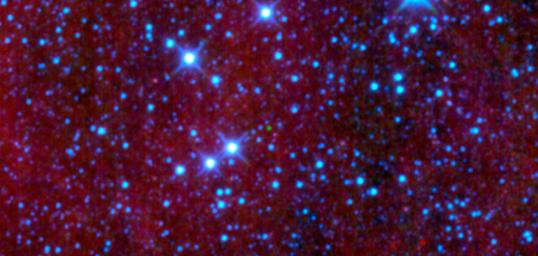That green dot in the middle of this image might look like an emerald amidst glittering diamonds, but it is actually a dim star belonging to a class called brown dwarfs. This particular object, named "WISEPC J045853.90+643451.9" after its location in the sky, is the first ultra-cool brown dwarf discovered by NASA's Wide-field Infrared Survey Explorer, or WISE. WISE is scanning the skies in infrared light, picking up the signatures of all sort of cosmic gems, including brown dwarfs.
The mission's infrared vision makes it particularly good at picking brown dwarfs out of a starry sky. This view shows three of WISE's four infrared channels, color-coded blue, green and red, with blue showing the shortest wavelengths of infrared light and red, the longest. The methane in the atmospheres of brown dwarfs absorbs this color-coded blue light, and the objects themselves are too faint to give off a lot of the red light. That leaves green. As can be seen in this picture, the little green dot of a brown dwarf stands out against the sparkly, hotter blue stars.
The brown dwarf is located 18 to 30 light-years away in the northern constellation of Camelopardalis, or the giraffe; in fact, the brown dwarf is positioned right on the neck of the giraffe, adorning it like an emerald necklace. This is one of the coolest brown dwarfs known, with a temperature of roughly 600 Kelvin, or 620 degrees Fahrenheit.
JPL manages the Wide-field Infrared Survey Explorer for NASA's Science Mission Directorate, Washington. The principal investigator, Edward Wright, is at UCLA. The mission was competitively selected under NASA's Explorers Program managed by the Goddard Space Flight Center, Greenbelt, Md. The science instrument was built by the Space Dynamics Laboratory, Logan, Utah, and the spacecraft was built by Ball Aerospace & Technologies Corp., Boulder, Colo. Science operations and data processing take place at the Infrared Processing and Analysis Center at the California Institute of Technology in Pasadena. Caltech manages JPL for NASA.
More information is online at http://www.nasa.gov/wise and http://wise.astro.ucla.edu.

 Planetary Data System
Planetary Data System












